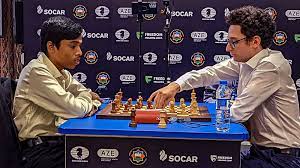Eighteen-year-old Indian prodigy R Praggnanandhaa could not pull off a repeat of his giant-killing acts of the last few days as fancied Magnus Carlsen beat him in the tie-break to win the in the final of the International Chess Federation (FIDE) World Cup in Baku, Azerbaijan last week. The two classical games on Tuesday and Wednesday had ended in draws, stretching the final into a tie-break.
After a keenly contested first game, the second game was a rather tame affair with Praggnanandhaa falling behind quickly and agreeing to a draw.
Carlsen, who had been under the weather due to food poisoning and did not look at his best in the first classical game, showed why he is so tough to get past with his remarkable comeback in the tie-break.
He ultimately beat Praggnanandhaa 1.5 – 0.5 in the tie-break to win the trophy. Norwegian Grand Master (GM) Carlsen, 32, became a first-time winner of the FIDE World Cup – with which he also retained his No. 1 global rank.
Praggnanandhaa defeated world No. 2 Hikaru Nakamura in the fourth round and eventually went on to shock world No. 3 Fabino Caruana 3.5 – 2.5 via the tie-break in the semifinals on August 21, earning the reputation of a ‘giant killer’.
Former world champion GM Viswanathan Anand had won the FIDE World Cup in 2000 and 2002. But, back then, it was held under a different format.
PM Narendra Modi hailed Praggnanandhaa for his remarkable performance at the FIDE World Cup and said he showcased exceptional skills to give a tough fight to the formidable Magnus Carlsen in the finals. “This is no small feat. Wishing him the very best for his upcoming tournaments,” he added.
Praggnanandhaa, or Pragg as he’s popularly known, made headlines for becoming the world’s youngest player to play in the finals and the third-youngest person to qualify for the Candidates Tournament, putting him in the league of prodigies like Carlsen himself and Bobby Fischer.
The teenager’s achievements have bolstered his reputation in the field. With younger players making a mark, it also signals a “generational shift” in the game itself and that shift “is likely to heavily favour India,” Devangshu Datta, a columnist and Fide-rated chess player wrote in The Times of India.
During this World Cup, four Indian players advanced to the quarterfinals, securing an impressive 50% of the available slots. Currently, there are 21 Indian players who hold positions within the top 100 junior players in the world, all under 20 years of age; among them, four rank in the top 10 and seven in the top 20.
These youngsters “will almost certainly dominate chess for a decade or more,” says Datta. And the theory is a plausible one, because thousands of young Indians are now playing chess – a trend that began in the 2000s after Anand’s victories made headlines – and has since steadily picked up speed.
Smartphones and cheap internet access have made it easy for children to hone their skills through apps and online tournaments, while basic chess coaching is easily available as well. This is significantly different from the way things stood even a couple of decades ago.
“For Indians players who arrived on the scene even two decades after Anand, access to regular training under a GM (Grandmaster) was almost inconceivable,” notes sports writer Susan Ninan in The Indian Express.

